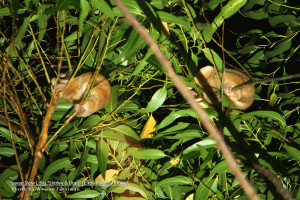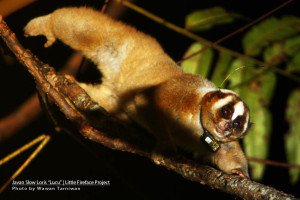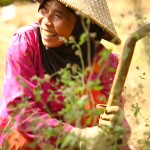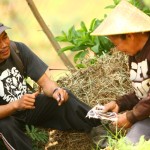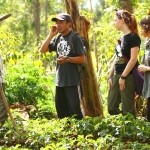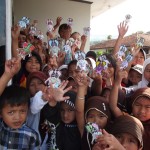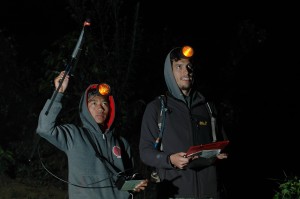Social lorises
Observing animals at night is no easy task! But the hours spent this week in the forest led to some wonderful discoveries! One of the younger study animals was being very friendly this week. On first shift we saw two lorises in the same tree. I got very excited and pulled out the video camera to zoom in on what I was seeing. Then looking at the screen I realized they were not sitting next to each other, but instead Utari and Mo were grooming each other. What a lovely sight one hanging upside down to groom the other. And my excitement did not end there as the very next night we found little Utari up in a tree all cuddled up to a female loris Shirley.
Where do the lorises sleep?
We’re starting an exciting new study here at Little Fireface Project: looking at the usage of sleeping sites by Slow Lorises. We want to find out whether there are common characteristics of the different sleep sites used by lorises. The findings of our research may allow us to propose a reason for the selection of certain sleeping sites. For example, Lorises may choose sleeping sites close to their favourite feeding trees or they may prefer to sleep in tall leafy trees which well conceal them from predators. It’s very exciting because this kind of research – which is becoming more popular with primatologists – has yet to be conducted for Slow Lorises! At the moment we just don’t know if Lorises consciously choose their sleeping sites!
The findings of our research might have significant implications for the future of Slow Loris conservation. Since primates spend almost half of their lives at sleeping sites and the presence of preferable sleeping sites might be essential for survival of the species. In the least, from our research we hope to gain a more thorough understanding of what constitutes “ideal habitat” for Slow lorises.
Earlier this week Denise and I headed out to begin to survey sleep sites under a blazing tropical sun. We followed directions to a GPS marked sleeping site used by one of our radio collared lorises less than two weeks ago. Sadly, we arrived at a completely barren field with scattered patches of scorched earth; there were no signs of any suitable sleeping site. Then we spotted blackened bamboo stumps on the far side of the field. A group of farmers sitting in the shade nearby were watching us, so we asked them if bamboo had been cut from the field. They nodded and told us it was cut down last week.
Rates of deforestation in Indonesia are the highest in the world, but its one thing to simply read this fact. However, it’s a much more terrifying reality when witnessed firsthand. A large area of Loris habitat was present one week and gone the next! And this is happening throughout the region. That’s what makes this research so important, if we can determine the characteristics of suitable sleeping sites we can make more informed decisions on which areas of habitat urgently need protecting. We’re in a race against time to save the land of the Loris!
Education, Education and Education.
This week we focused on education here at the Little Fireface Project headquarters.
This week we went to the farms. The slow lorises around the LFP green house live in a mosaic environment also known as an agroforest environment. This means that the forest patches are interspersed with farmlands. Because the lorises live in such environments it is really important to inform the local people of their presence on their farms and the positive effect of lorises to their farms.
We went out as a small team and told the farmers about the fact that lorises eat their crop pests as they are insectivorous, that they don’t eat their crops, but, do pollinate them. The farmers were so excited to be given information and most had seen lorises on their farms. We hope that with such information they will be proud to have lorises on their farms and protect them from possible. We gave them all a beautiful loris bandana and sticker to keep!
Our next education trip led us to the local school on Saturday morning to teach the children about the lorsises. We had a lovely morning in which the children wrote stories about the lorises. Though not used to writing stories and with some hesitant glances we ended up with some very accurate and lovely accounts of lorises living in the forest. Some even featured quotes like, “don’t keep lorises as pets”, “lorises are forest protectors” and “don’t let them vanish.” After that we taught them the English names of 10 loris related words. Want to try your hand at some Bahasa Indonesian?
- Loris: kukang
- Forest: hutan
- Night: malam
- Tree: Pohon
- Flower: bunga
- Pollinator: penyerbukan
- Insect: serangga
- Farmer: pentane
- Venom: racun
- Love: cinta
“Saya cinta kukang” therefore means “I love the loris” and by the end of the class the children were all saying this with pure excitement and joy.
Nature Club
It is a sad reality that here in Indonesia much of the children’s education lacks creativity or the opportunity for them to use their imagination. So it is no surprise that when we asked the children what they most enjoy doing during the LFP nature club sessions, that they replied ‘’Stories and drawing!’’. This is of course what the LFP nature club is all about, fun, creative conservation education and so this week’s session was just that! Taking inspiration from our wonderful forest protector teacher’s pack, Boris the loris finger puppets came along to the session and the children all got to decorate their own. We had some very lifelike creations but also some multi-coloured Lorises too! There were even some accidents when making the small finger slots ending in a few legless Lorises but overall it was a successful colouring session and the children seemed more than proud with the results. As newly budding forest protectors and with their love for stories we decided to end the session reading our very own ‘’Loris forest protectors’’ book written by Dr. Anna Nekaris herself. The children settled down for the story with intense excitement and listened quietly as Pak Dendi read to them. Bringing the story to life Pak Dendi animated each page with funny movements and voice impersonations. The children laughed and smiled all the way through! As I watched the children and the story came to an end, I couldn’t help but smile to myself knowing that fun and creative conservation education in Cipiganti is here to stay and so are the smiles on all the children’s faces. Nature club rules!
Sad goodbyes
We want to end this week’s blog post with a large thank you to volunteer Markus Lazarte. Markus came to Cipaganti for 3months to help collect data on the behaviour of the lorises and mapped out our entire study site! We are very thankful and wish him all the best of luck in his masters degree.

